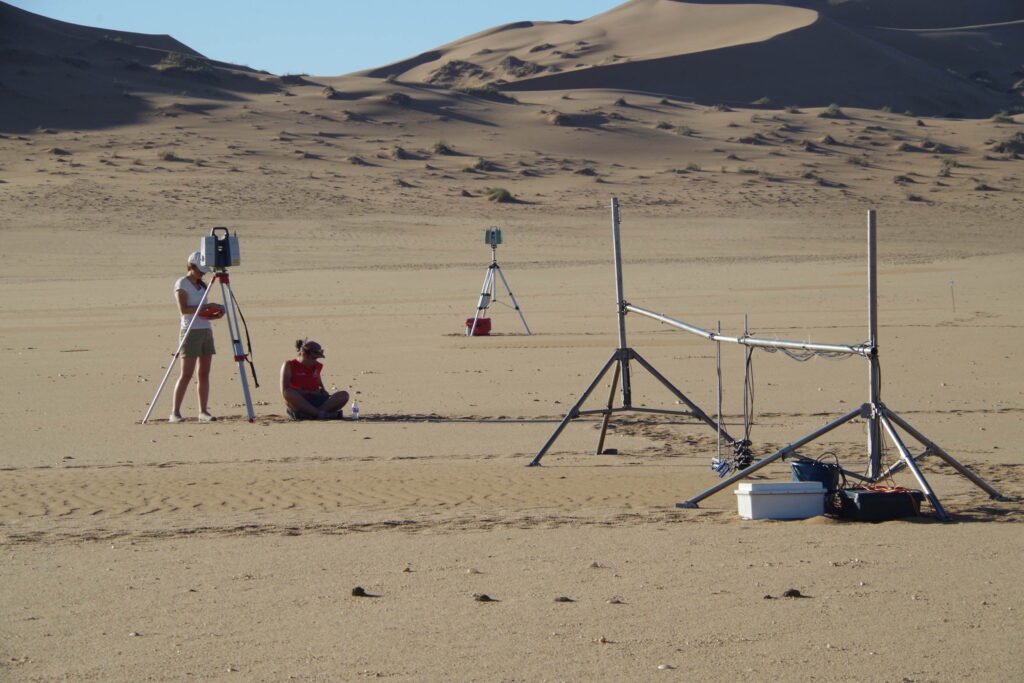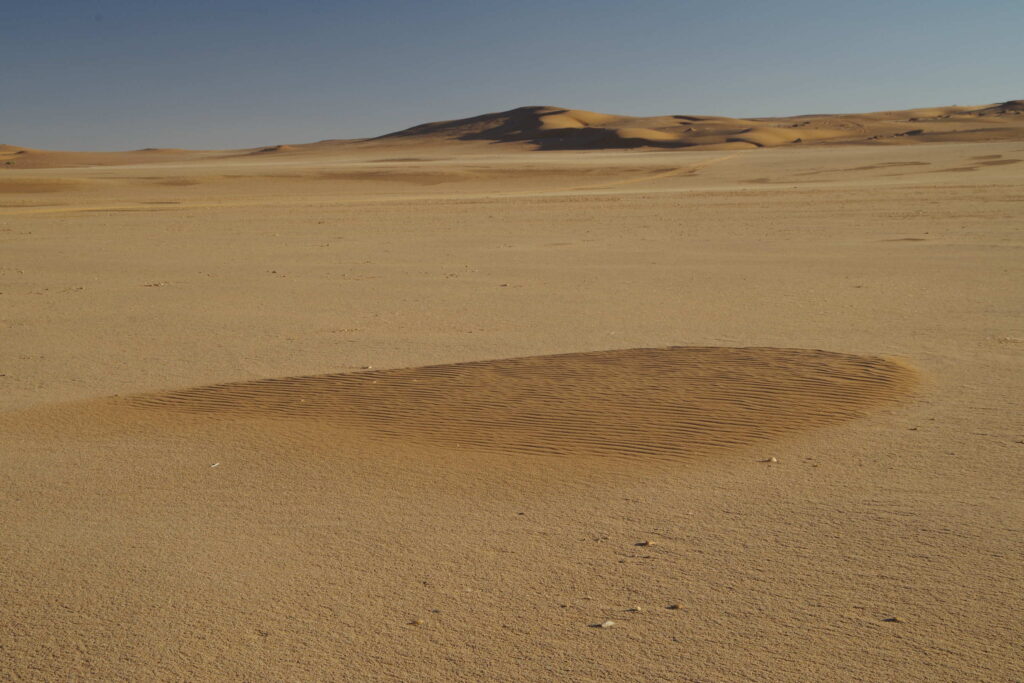Next time you explore a beach or a desert, look down at the sand. You might spot patches of small ripples just a few centimeters tall. Wind can shape these miniature dunes in less than half an hour and blow them away just as quickly. Unlike the processes that form larger dunes that define desert landscapes and shorelines, those that shape mini dunes have been elusive.
“There have been some observations of such small, meter-scale bedforms, but not many quantitative studies,” said Camille Rambert, a doctoral student at École Supérieure de Physique et de Chimie Industrielles de la Ville de Paris and lead author on the new research. “And there have not been any models to explain their formation.”
Recently, a group of researchers used high-resolution laser scanning in the Namib Desert in Namibia to watch how tiny dunes form. Those scans informed dune formation models, which found that the key factor is how sand grains bounce on smooth versus grainy surfaces.
Blowing in the Wind
Although small sand bedforms are a common phenomenon in most sandy places, their ephemeral nature has made it challenging for geomorphologists to decode what makes a small dune form where only flat, featureless sand exists.
“More sand can be transported on a consolidated surface than on the erodible surface.”
A team of researchers, including Rambert, set out to the Namib Desert in coastal southern Africa seeking to understand how these bedforms take shape. The team used a laser scanner sitting on the surface to collect repeated high-resolution topographic maps of nearby flat areas, roughly 5 meters wide × 5 meters long, nestled between larger dunes. The scanner measured the distance from the laser emitter to the ground and also measured near-surface wind speed and direction. The team could detect vertical changes to the surface of about half a millimeter and horizontal changes of about a centimeter.
“From those measurements, we can deduce how bedforms evolve,” Rambert said. “Do they grow and migrate, or do they shrink?”
They developed a mini dune formation model on the basis of well-established physics governing large dune formation, but with a key twist: The small dunes started on consolidated surfaces like gravel or hard-packed sand rather than on an erodible foundation such as loose sand. That difference altered how far wind could transport a sand grain and how the grain bounced or stuck when it landed.

“This difference in surface materials affects the sand transport,” Rambert said. “More sand can be transported on a consolidated surface than on the erodible surface.”
If a grain wasn’t swept away by the next gust of wind, its presence made the surface a little rougher and more likely to trap the next grain of sand—and the next. The gradual buildup of grains into tiny bumps altered near-surface wind patterns, which helped trap even more sand and created distinctive dune patterns in the bedform.
These patches of mini dunes disappeared when a strong enough wind blew the sand grains off the consolidated surface. If the wind had been gentler, those patches might have continued growing.
The team found that their model observations accurately portrayed what they saw in the laser scans from the Namib. They published these results in Proceedings of the National Academy of Sciences of the United States of America.
“This study highlights the importance of bed heterogeneities, such as whether a surface is sand covered or not, in how meter-scale bedforms evolve,” Joel Davis, a planetary geologist at Imperial College London in the United Kingdom, wrote in an email. Davis was not involved with the research. “It’s intriguing [that] those small-scale variations in dynamics…could influence whether these small bedforms become a larger dune field, or simply disappear.”
Dunes Beyond Earth
Scientists have discovered dunes on both Mars and Saturn’s moon Titan, but the instruments that have explored those distant worlds are far less advanced than the laser scanners on Earth.
“Studies like these, on the dynamics of Earth dunes, are particularly useful for investigating dunes in a planetary setting, such as on Mars or Titan,” wrote Davis, who studies Martian dunes.

Some of Mars’s dunes form inside craters, which presumably trap a lot of loose sand, but they are also found outside the craters in less sandy areas. “We don’t really know why they have formed in these locations, but perhaps bed heterogeneities are a control on this,” Davis wrote. “It would be interesting to see if we could identify any metre-scale bedforms in these expansive interdune areas of Mars…similar to the Namibia examples.”
What’s more, Earth’s dunes tend to be either very short (centimeters) or very long (tens to hundreds of meters). Though hundreds of dunes near Mars’s north pole are the same shape as Earth dunes, most of them are 1–2 meters long. Planetary geologists are still puzzling over this.
“Mars, and also other planetary bodies such as Titan, are, in a way, laboratories where the physical conditions are different than on Earth.”
“This is a hotly debated topic that is rapidly evolving,” wrote Lior Rubanenko in an email. Rubanenko is a planetary surfaces researcher at the Planetary Science Institute in Tucson, Ariz., who was not involved with the new research.
“Mars, and also other planetary bodies such as Titan, are, in a way, laboratories where the physical conditions are different than on Earth—different atmospheric density, different grain size and material type,” Rubanenko wrote. “This allows us to conduct and observe ‘planet-size’ experiments which challenge our current paradigms.”
“Comparing observations of dunes between these planets can help us better understand the mechanisms that govern sand transport and dune formation,” he added.
—Kimberly M. S. Cartier (@astrokimcartier.bsky.social), Staff Writer

